Darkness had descended on Colombia's southern Putumayo province one February night last year when gunfire roared through the air, shattering the peaceful dusk.
Villagers attending a meeting scattered and fled. Leidy Mendoza watched in horror nearby as her teenage son rushed to save his five-year-old brother, who ran off when the shooting started.
"Hit the floor!" Mendoza shouted as bullets slammed into the buildings. But it was too late — one hit her oldest boy's leg.
Mendoza, a former fighter for the now-disbanded Revolutionary Armed Forces of Colombia (FARC) guerrillas, dragged her children back inside the house.
"I started screaming like a mad woman, 'help me, Jorge!'" Mendoza said. "I didn't know they'd killed him already."
Her husband, Jorge Santofimio, an environmentalist who led a network of tree nurseries across Colombia's Amazon region, was shot several times in the abdomen from close range and died instantly, according to at least three witnesses and Colombia's attorney general's office. His killing remains unsolved.
In response to questions about Santofimio's death and other killings, the Environment Ministry said conservationists are often targeted because their work poses a threat to illegal activities and acknowledged that environmental projects "can be affected and slowed down due to security risks."
Globally, at least 1,910 environmentalists were killed for their efforts to protect nature against business and criminal interests between 2012 and 2022, according to British advocacy group Global Witness. Last year, Colombia had the heaviest toll, 60 killings.
Colombia's government is working to protect environmentalists, Environment Minister Susana Muhamad said in an interview this month, describing each killing as a tragedy.
"In the past they were stigmatized," said Muhamad, who took office in August 2022 as part of Colombia's first left-wing national government. She said environmentalists had often been painted as obstacles to development.
"Nobody deserves to die for safeguarding life," she said.
Reporters examined the aftermath of Santofimio's shooting and the murders of two other environmental activists — one in 2020 and 2021 — to assess the impact on their work to conserve and restore rainforest, as well as protect wildlife, drawing on testimony from three dozen sources, including activists, scientists, lenders, advocacy groups and government departments.
In interviews, those people recounted how the attacks left conservation projects adrift, with conservationists withdrawing from environmental protection works because of fear of more violence. Security issues also caused delays to the disbursements of funds, they said.
Municipal data from local environmental authorities and the Colombian Institute of Meteorology (IDEAM) also showed that in the year after each killing, deforestation at a local level was worse than national trends.
Any pause in conservation projects tipped the balance in favor of deforestation and destruction, environmentalists said.
"They keep logging without pause," said Armando Aroca, who now leads the network of tree nurseries that Santofimio headed. "They keep mining." Aroca didn't specify to whom he was referring.
Santofimio's killing brought his hard-fought conservation project to a halt. Funding was delayed, a tree nursery was forced to close, and staff abandoned vital work like gathering seeds in the jungle and planting saplings.
Rebel turned environmentalist
Like his wife, Santofimio was a former FARC rebel. The group relied on Colombia's lush jungle for safety when it fought the government and, after a 2016 peace deal, Santofimio turned to protecting his former home — leading a network of tree nurseries across Colombia's Amazon, including one run by Comuccom, the settlement he called home.
Santofimio, called Jorgillo by friends, had received multiple threats, he said in August 2021, without disclosing who made them.
"Here, they won't kill you for being a peace signatory," he said, six months before his death. "They'll kill you for wanting to build peace."
His killing was designed to terrorize the community, Duberney Lopez, president of the Comuccom cooperative, founded by former FARC fighters, said in June. He said attackers had plenty of chances to kill Santofimio more discreetly on his motorbike rides through the region.
"There are interests that don't want us to stay here," Lopez said, declining to identify who may have been behind the attack, citing security concerns.
Colombia has struggled to end some six decades of conflict between the state, leftist guerrillas and criminal groups descended from rightwing paramilitaries, which has left at least 450,000 dead.

The 2016 peace deal with the FARC came with environmental costs as territory previously controlled by the group was opened to cattle ranching, illegal gold mining, and drug crops like coca, the chief ingredient in cocaine, sending deforestation soaring.
"It's no coincidence that the main attacks on environmentalists take place where there is coca," said Kevin Murakami, Director of the International Narcotics and Law Enforcement Affairs at the U.S. embassy in Bogota.
Successive governments have blamed Colombia's armed groups, which include the leftist National Liberation Army (ELN) guerrillas, a rebel group founded by Marxist priests in 1964, and the Clan del Golfo crime gang, for killing environmentalists. Those groups were unavailable for comment.
Tree nursery closed
Santofimio had been working with the U.N. Development Program (UNDP) to build a network of tree nurseries in the provinces of Putumayo, Caqueta, Meta and Guaviare. Under his leadership, the network expanded to more than a dozen nurseries and aimed to rear up to 1 million trees over two years.
After the killing, the disbursement of funding worth $149,000 — a princely sum in Colombia — by the UNDP was delayed for six months, members of Comuccom said. The setback was due to administrative delays arising from Santofimio's death, the UNDP said in a statement.
Elsewhere in Putumayo, a tree nursery with a capacity to rear 150,000 trees per year closed due to fear among workers and the absence of Santofimio's leadership, a project leader who asked not to be identified told reporters.
Progress in other regions stalled as well, Aroca said.
Tree production across the network over two years was around 250,000, Aroca added, just a quarter of Santofimio's goal.
Bullet-proof vests
Two years before Santofimio's killing, forest ranger Javier Franciso Parra was working in the town of La Macarena one December morning in 2020 when a gunman shot him several times through an open window. He died waiting for a medical evacuation.
"Francisco couldn't hold on any longer," said Andres Felipe Garcia, the then-director of Cormacarena, the local environmental regulator where Parra had worked.
The murder was ordered by a faction of former FARC rebels who rejected the peace deal, according to Colombia's attorney general's office. The dissident faction tried to extort Parra and Cormacarena for more than $14,000 per month for access to nearby protected reserves, prosecutors said in a statement, adding that when the money was not paid, the group ordered Parra's murder. Two people have been charged in the case.

The suspects, their lawyers and the FARC dissident faction were unavailable for comment.
Both local and national forest services withdrew staff from the area, Garcia said. Parra's killing "stopped work being done with, let's say, the same energy as before," he added.
Seventeen rangers from the national parks agency (PNN) have been murdered since 1991, PNN director Luisz Martinez said.
"I have rangers who have protection measures — bodyguards, bullet-proof vests, and others have had to be moved from one place to another," Martinez said. "We even have cases of rangers in exile."
Efforts to restore two national parks in Meta, including La Macarena, are running three years behind schedule, Martinez said. The efforts are funded with part of a €35 million ($37.5 million) package from German state bank KfW.
Implementation of the project "is delayed considerably," KfW said, adding that setbacks were caused by security issues, as well as the coronavirus pandemic and staffing changes.
Environmental advocacy group the World Wildlife Fund (WWF) has also struggled with a proposed $1 million, five-year project in La Macarena municipality, citing security issues.
Security issues disrupt projects across Colombia. Amazonia Mia, an environmental project from USAID, has changed locations for two or three projects after communities warned of security concerns in areas where they were first planned, group director Roberto Gomez said.
Deforestation ticks up
Municipalities affected by the three environmentalist murders saw increased deforestation versus levels nationally, government data showed.
Following Parra's murder, deforestation in La Macarena municipality increased by 14% in 2020 to just over 13,000 hectares, rising by nearly twice the national rate that year. Most of the destruction happened in the weeks after Parra's shooting in December, Garcia said.
Likewise in Putumayo in 2022, even as deforestation declined 29% across Colombia versus 2021, in part due to the wetter La Niña weather phenomenon, deforestation in Puerto Guzman, where Santofimio's project is based, rose 0.6% to 4,645 hectares. That was the highest level of Putumayo province's 13 municipalities — according to IDEAM.
The third case examined was that of conservationist Gonzalo Cardona who worked with bird advocacy group ProAves to protect the endangered yellow-eared parrot and was killed in 2021. Nobody has been charged in the case. "It was a huge blow," said Sara Ines Lara, executive director of ProAves, adding that four park wardens resigned after deciding it was too dangerous and the group had to spend more on security.
Santofimio's colleagues have gradually gotten back on their feet.
In the tree nursery, which stopped work after Santofimio's killing, saplings bask in the dappled sunlight beneath protective nets. Capable of rearing 30,000 trees a year just before Santofimio's death, the nursery now boasts a capacity of 100,000 a year, Lopez said.
Wandering among the rows of young plants, Lopez reflected on Santofimio's legacy.
"This is Jorgillo's triumph over death," he said.








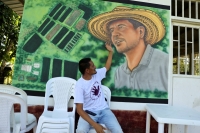

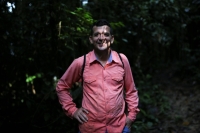

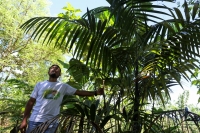
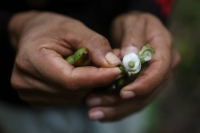
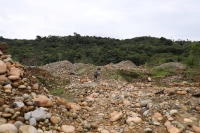















With your current subscription plan you can comment on stories. However, before writing your first comment, please create a display name in the Profile section of your subscriber account page.